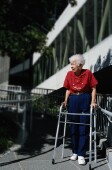- Double Mastectomy May Offer No Survival Benefit to Women With Breast Cancer
- Toxic Lead Found in Cinnamon Product, FDA Says
- Certain Abbott Blood Sugar Monitors May Give Incorrect Readings
- Athletes Can Expect High Ozone, Pollen Counts for Paris Olympics
- Fake Oxycontin Pills Widespread and Potentially Deadly: Report
- Shingles Vaccine Could Lower Dementia Risk
- Your Odds for Accidental Gun Death Rise Greatly in Certain States
- Kids From Poorer Families Less Likely to Survive Cancer
- Tough Workouts Won’t Trigger Cardiac Arrest in Folks With Long QT Syndrome
- At-Home Colon Cancer Test Can Save Lives
Two-Thirds of Seniors Need Help With Some Part of Daily Living


Two-thirds of people over the age of 65 need help completing the tasks of daily living, either from special devices such as canes, scooters and bathroom grab bars or from another person, new research shows.
“If people are finding ways to successfully deal with their disability with help from devices or people, or they’re reducing their activity because of a disability, I think these groups are probably missed when we look at public health needs,” said study author Vicki Freedman, a research professor at the University of Michigan Institute for Social Research.
“How people adapt to their disabilities is important, and it helps us identify who needs public health attention,” Freedman said.
The study identified five levels on the disability spectrum: people who are fully able; people who use special devices to work around their disability; people who have reduced the frequency of their activity but report no difficulty; people who report difficulty doing activities by themselves, even when using special devices; and people who get help from another person.
One expert said the findings shed light on how many seniors are struggling with different levels of disability.
“The fact that about 25 percent of people are unable to perform some activities of daily living [without assistance] wasn’t surprising,” said Dr. Stanley Wainapel, clinical director of the department of rehabilitation medicine at Montefiore Medical Center in New York City.
“What was interesting to me was that this study gave me more information on the other 75 percent,” Wainapel said. “Just because 25 percent cannot do at least one activity of daily living doesn’t mean the other 75 percent can get along just fine. It’s not as black and white as we might have thought.”
“There’s a Twilight Zone area between those who are perfectly fine and those who aren’t, and these are the people who can probably be helped most with rehabilitation therapy or assistive devices,” he said.
Results of the study were released online Dec. 12 in the American Journal of Public Health.
Data for the current research came from the 2011 National Health and Aging Trends Study. The study included more than 8,000 Americans over the age of 65, about 500 of whom were living in a nursing home.
Those living at home participated in interviews about their physical capacity and ability to carry out activities of daily living. They also were given tests to measure their physical and thinking abilities.
Freedman and her colleagues found that 31 percent of adults older than 65 were able to take care of themselves with no assistance. About 25 percent were able to take care of themselves using some sort of assistive device, such as bathroom grab bars or a cane. Another 21 percent received help from other people, and 18 percent reported having difficulty completing daily tasks even with accommodations. About 6 percent of the study subjects scaled back on certain activities.
People’s abilities varied greatly by the activity studied. Ninety percent of seniors can feed themselves with no help, but barely half can bathe without some kind of assistance.
Not surprisingly, people’s ability to complete tasks on their own decreased with age. Only 4 percent of people aged 90 or older didn’t need any help, compared to 45 percent of those aged 65 to 69.
Women are more likely than men to turn to assistive devices, and whites and Asians are more likely to use assistive devices than blacks and Hispanics, according to the study. People with lower incomes also are less likely to use assistive devices to counteract a disability.
“If you’re having difficulties with daily activities, there may be ways to address those issues that can help you participate in the things you enjoy and help improve your quality of life,” Freedman said.
Wainapel agreed that people shouldn’t isolate themselves. If they need help, they should talk to their doctor, he said.
Wainapel said there are a lot of things that can be done, including making changes to the home, losing weight and using assistive devices. Medicare pays for most durable medical equipment, such as canes and walkers, he added.
“Doing things on your own and maintaining the ability to get around helps you be connected with others, and that’s a very important part of healthy aging,” Wainapel said.
More information
Learn more about assistive devices, including what types are available and how to get them, from the Family Caregiver Alliance.
Source: HealthDay
Copyright © 2024 HealthDay. All rights reserved.










